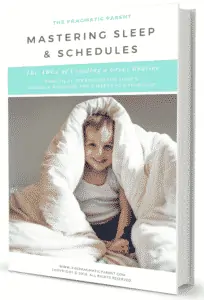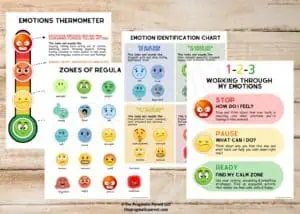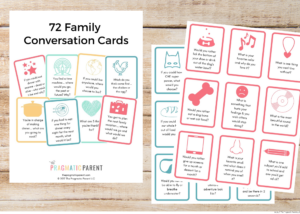Is your child scared of the dark? Have they started acting afraid of the dark at bedtime and say things like there are monsters hiding in the closet, ghosts who come out at night, something scary under the bed or act plain scared when the lights go off? This phase is very common in kids 2 – 9 years old, but these expert tips will help you ease night time fears and help your child overcome being scared of the dark. Try the Emotions Identification Bundle to help support your child in learning, naming, and communicating their feelings and deep dive into what’s going on, on the inside.
Dark rooms, a monster in the closet, something scary hiding under the bed or lurking around the corner… these night time fears while may seem irrational to the parent who knows they aren’t real, but for a child scared of the dark, they’re very real.
Little kids don’t have the understanding yet to decipher what is real and what isn’t when they see things on the TV, read about scary stuff in books, overhear or even at Halloween when everyone is walking around in ghoulish costumes. Understanding fears is a learning process which can be eased with patience and effort.
First, you must recognize there is more at play here with your child’s fear and now it’s time to play detective. Remain calm, lead with empathy and you will be able to help them overcome this night time anxiety without exacerbating the fear.
When nighttime fears strike, use these expert tips to ease your child’s anxiety around being afraid of the dark and start getting to to sleep more easily.
1. Play Detective About Why They’re Afraid of the Dark
As a parent, we understand there is nothing hiding in the closet after we’ve turned off the light and left the room at bedtime. It’s easy to offer a simple rationalization to their but telling them simply there isn’t anything to be scared of, won’t do any good.
The problem will keep persisting until your child understands for themselves – on their own – there is nothing to be afraid of when it’s dark.
First empathize and offer your understanding that being in the dark can feel scary. When it’s dark, we can’t see what’s around us and sometimes our eyes play tricks on us. Turn on the light, or better yet, let your child turn on the light to check things out for themselves when they feel scared.
A temporary solutions would be adding a glowing alarm clock or lamp on a bedside table and spread nightlights around the room to help illuminate the dark areas. If these areas don’t have outlets, stick a battery-operated tap light in those places for bedtime.
Steer the conversation about where your child developed their fear. Was it a movie, Halloween decorations, a scary book or story they overheard? Help your child find the point where the fears started and then you can help them rationalize on their own how the fear isn’t real.
Don’t ask leading questions like “was it the scary ghost you saw on the TV today?”
Instead, let your child answer the question so you can get to the real bottom of the fear. It might be something completely unrelated to what you perceive as “scary” so it’s important to let them give insight without tampering with their thoughts.
2. Scared of the Dark: Imagination at Play
Toddlers and preschooler’s imaginations roar to life not only during playtime, but at night too. From the age of 2 until 8 or 9, bedtime fears – the dark, monsters in the closer and being in their bedroom by themselves – are common night time fears.
Along with imagining a sword fight on a pirate ship in your backyard, kid’s imaginations are exploding with new and scary scenarios too. Even familiar things like their bedroom, coat closet or hallway can be conjured into a frightening place.
Imagination is wonderful, but remember children this age can’t distinguish reality from make-believe so a monster hiding in the closet is very real to them.
Talk about the scary stuff making them afraid and then write down the worries on a piece of paper. This special stuffed animal, the Worry Eater, will devour the fear and shred it to pieces. Your child’s imagination will come to life envisioning the Worry Eater going to down destroying the monster under the bed.
3. Eliminate The Scary Stuff to Ease Night Time Fears
Continued exposure to what’s frightening your child isn’t going to help them overcome it.
Put away the scary books, turn off the tube, limit exposure on tablet apps and movies which depict even minimally scary or violent themes, and avoid the Halloween aisle and the chance of setting off sensory activated ghouls until they’re older and can separate what’s real from what’s not.
Before bed, avoid conversation, books and exposure to things which will trigger night time fears.
Another helpful tip is to take a night walk with your child in their room and ask them to point out the areas of the room where the shadows or dark spots scare them. This might be as simple as moving a couple pieces of furniture or putting away dolls before nighttime.
Some bedtime books about overcoming being afraid of the dark can be a great addition to your bookshelf.
4. Empower Kids to Fight Their Fears
It’s hard to face scary stuff – but for the anxious child who is struggling with bedtime, encourage them to fight this battle head-on. You don’t want to admit that the fear is real (especially if they think something is going to grab them from under the bed), but you could go with your child to check under the bed, in the closet and behind the curtains before lights go off to reassure them.
Add a bottle of Monster Spray or Zombie Repellent to your bedtime routine to keep the monsters away at night. Let them squirt away before they get into bed, and they’ll feel better knowing they’re untouchable while they drift off to sleep.
Try the Emotions Identification Bundle to help support your child in learning, naming, and communicating their feelings and deep dive into what’s going on, on the inside.
5. Add Comfort & Lights to the Bedroom
Comfort items differ based on your child, but a slew of stuffed animals on the bed could feel like a fortress or army to a scared little boy who is afraid of the dark. Comfort items give an anxious child a sense of being protected and feel safe during the night.
Nightlights or tap lights around the room help to illuminate dark spots, but there are also different lighting options which are calming and comforting at the same time.
Glow Orb Nightlights are soft and can be set on the side of the bed or kept in bed.
Star projectors shine celestial scenes on the ceiling and are not only mesmerizing but calming.
Let your child sleep with a kid-friendly flashlight, as long as they aren’t playing with it and it keeps him up well past bedtime.
Snap a few glow sticks and hang them around the room or put them on the floor.
Facing fears and overcoming them won’t disappear after one night. This takes time and a lot of patience. You may have to try a few approaches and have a couple conversations with your child to get to the true root of their fear, but don’t give up. You can do this!
Helpful Resource for Handling Sleep Problems, Sleep Regression & Mastering Your Routine
For a more thorough explanation and resource of keeping a routine, Check out the Mastering Sleep & Schedules Ebook which is 97-pages of jam-packed information and 40+ sample routines. All the tools, sample schedules, sleep tracker and strategies for every age and stage of development for 2 weeks to 5-years-old. Learn how to start the process of creating a routine, establishing wake up and bedtimes, strategies for working through nap transitions, prepping for daylight savings time to keep your routine on track and logging your baby’s sleep patterns to rocking a solid schedule through every age of growth.
Additional Reading on This Topic
- How to Ease Separation Anxiety in Babies, Toddlers & Preschoolers
- 8 Common Toddler Sleep Problems & How to Handle Them
- 7 Ways to Beat Bedtime Stalling with Young Kids
- Is Your Kid Waking Up Too Early? How to Fix It
- 10 Helpful Ways to Calm the Kid Who Fights Bedtime
- Toddler Sleep Regressions: What You Need to Know About Your Two Year Old’s Sleep
- How to Establish a Peaceful Bedtime Routine for Your Baby
- How to Survive the 18 Month Sleep Regression & 2 Year Sleep Regressions Without Going Crazy
- Comprehensive Sleep Charts & Sleep Guidelines for Infants Through Adolescents
- The Benefits of Having a Daily Routine
- Create an Awesome Routine for Better Sleep Habits






